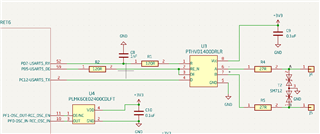Other Parts Discussed in Thread: ESDS452, ESDS552, TSD05
Tool/software:
Hello E2E Community,
We are using THVD1400 for our RS485 use case with a maximum data rate of 20kbps. The maximum trace lengths on the PCB from THVD to MCU are less than 6cm.
I would like to confirm from your expert review if we can continue using following configuration for our end product, especially:
- RC Filter at Rx: The MCU Errata has suggested to add a heavy RC Filter - is a capacitance of 10nF okay with R of 120Ohm in this RC configuration?
- Series resistor of 120R on the DE trace for added noise immunity
- No resistor on the Tx line (Do we need to add any series resistor here to dampening?)
- Use of 27Ohm series current limiting resistor (pulse proof) on the A & B inputs after the ESD diode (Can we use 49ohm resistor instead of 27ohm here?)
All resistors here are 1% accuracy & are pulse withstanding.

Further we have

